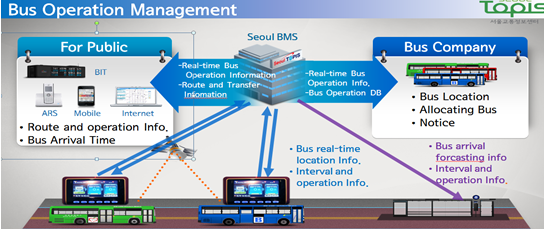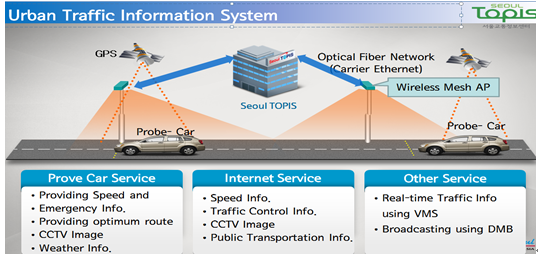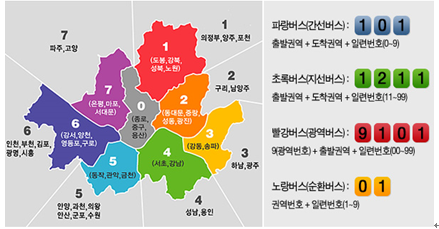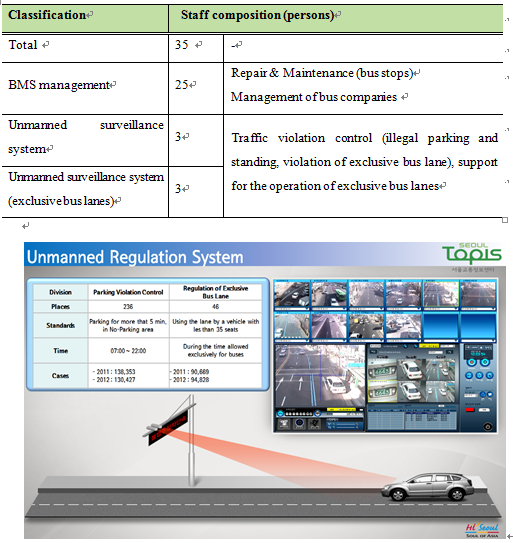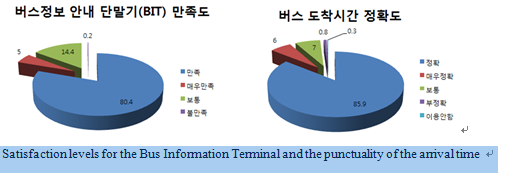مركز معلومات نظام المواصلات العامة والمرورفي سيول (TOPIS)
Policy Overview
“An emergency on the city's roads automatically triggers an alarm system and informs all concerned parties; police stations, bus operators and citizens. The real time on-site information obtained through surveillance cameras enables a swift response.” The Transport Operation and Information Service (TOPIS) of the Seoul Metropolitan Government, the "control tower" for Seoul City’s transportation system, makes all this possible. It gathers and processes the city’s road traffic and subway train information real-time to enable the city to efficiently manage the interval between buses, relieve congestion and take timely action in case of an accident.
Background Information
- Mounting challenges with the pre-existing transportation system
Seoul’s transportation system had suffered from chronic problems caused by the growing number of vehicle owner-drivers, deteriorating service quality of intra-city buses, and the inadequate subway system. Despite the various efforts by Seoul City, such as the opening of new subway lines and expansion of road networks, the city’s already-saturated transportation facilities were revealing serious limitations. Thus, the need for a highly advanced transport information system emerged and its implementation became urgent.
- Need for an integrated information system seamlessly linking various transportation demands
Since some 30 years ago, the city has enforced diverse transportation policies, some of which worked temporarily. Still, an integrated system that can connect various transportation demands e.g. the municipal government, transportation companies, drivers and citizens, was needed as a more fundamental and affordable solution. This meant not just practical measures such as more exclusive bus lanes and oil subsidies, but also an integrated information system that will enable a comprehensive management thereof.
- Absence of a system that can consolidate and manage transportation information
Various information involving transportation cards, bus operation, traffic volume, speed, emergencies like accidents and protest rallies on roads, expressway conditions was produced by many different sources − including the SMG, the Traffic Broadcasting System (TBS), the Korean Expressway Corporation and private bodies concerned. As each organization and system produced information in its own format, a consistent and integrated management was critical.
Goals and Objectives
-Real- time information-sharing and management of bus operation: Enhance user convenience and attract more passengers to public transportation
- Collect traffic information to help alleviate road congestion and respond more quickly and efficiently to unexpected situations.
- Analyze the accumulated information to devise scientific public transportation policies
Implementation and Expertise
-Real-time monitoring of traffic and information
The SMG discloses real-time traffic information 24 hours per day throughout the year. By linking 741 CCTVs in the city, it can figure out traffic conditions of major roads at a glance and share the road control and congestion information, such as if there is any accident, roadworks and protest rallies, with the Seoul Police Agency and the TBS. Citizens can also check any outbreak of unexpected situations through the city’s website, mobile-apps, and SNS (Twitter, etc.).
< Average number of cases reported per day >
| Case | Roadworks | Accidents | Rallies | Total |
| No. of information offerings | 9 | 43 | 1 | 53 |
- BMS; Bus Management System for more scientific operation of intra-city buses
The system, utilizing satellite technology, innovated Seoul city’s bus operations (9,400 vehicles and 610 routes), leading to a significant increase in punctuality and accuracy of the operation intervals.
<Providing information through BMS >
- Real-time information on public transportation operation (subway, bus)
Citizens now benefit from real-time traffic information including arrival times on bus routes and bus stops, subway operation through various means, e.g. the Internet, mobile devices, BIT, and QR code. As the city now even allows private developers to utilize the information, the service has become truly ubiquitous.
- Complete overhaul of bus numbering system
For consistent management of traffic information, a bus with a particular number was supposed to operate on a given route. However, in Seoul, the numbers were allocated as requested by bus companies, causing the system to be less organized and confusing. Thus, users found it difficult to trace the linkages between old numbers and new ones whenever a route was removed or newly created. To resolve this issue, the SMG implemented a reform orientation by which a bus number indicates the driving direction so that users can now easily match stopovers and destinations. Buses are now classified into trunk, feeder, inter-regional, and circular lines, color-coded with blue, green, red and yellow respectively.
< Bus numbering principles >
- Evolution from TOPIS 1.0 to TOPIS 3.0
The Traffic Operation Information System has evolved from the era of the ‘Cutting-edge (TOPIS 1.0)’ to ‘Openness (TOPIS 2.0),’ through to the current ‘Collaboration (TOPIS 3.0)’. It is now seeking to share its know-how with foreign cities, along with private tech- companies, while bracing itself for the future transportation needs such as traffic forecasting systems using big data.
Limitations and solutions
- Fierce opposition from interested parties such as bus companies and street vendors
While setting up the TOPIS, the city government also carried out the exclusive median bus lane system and the Quasi-public Bus Operation project, too. In particular, the median bus lane was inevitable to ensure punctuality and even intervals. Despite its good intentions, however, the city faced strong resistance from interested parties e.g. bus companies opposed to the quasi-public operation, and street vendors against the idea of moving bus lanes from roadside to center lanes.
Solution: Active promotion toward citizens and consultation with affected parties
Faced with the resistance from street vendors, the SMG tried to persuade them through continuous discussion. Along with the bus association, it organized workshops for the reform of Seoul’s bus operation system, where it coordinated conflicting views and guaranteed management rights and reasonable compensation respectively to bus companies and street vendors. As a result, it could secure consensus among them after multiple rounds of negotiation.
- Lack of cooperation between related agencies
Building a framework for information-sharing and smooth cooperation among all the relevant parties was not easy, and thus limitations followed in encouraging active participation from them.
Solution: build a consensus through continued discussion
Faced with these obstacles, the city continued discussions with all the concerned parties including police stations, fire stations, military bases and nearby local governments to gain consensus on the need of building an integrated transportation management system.
Resources
- Budget: Approximately KRW 200 billion
As the city was the first local government in the nation to develop such an intelligent transportation system (ITS), the project commenced in 1998 entirely financed by the municipal budget, without any support from the central government. However, the benefits of the system soon became known to other local governments, and the central government came to recognize the need, so some of the city’s additional projects are now subsidized by the state on a 50-50 basis.
- Human resources
In the initial stage, a total of 29 professional human resources planned and developed the system. As for the on-site facility management and maintenance such as electronic road signs, it has been outsourced or consigned to private enterprises.
< Staffing for TOPIS (2008)>
- Revision of laws and regulations
The ITS is based on the National Transport System Efficiency Act and the city continued to ask for the revision and succeeded in making the ITS buildup eligible for the state subsidy since 2008.
Results and evaluation
- Bus users: Rising customer satisfaction
Users’ satisfaction level has risen with the real-time bus operation information available. They gave high marks to the service quality improvement as they feel more comfortable with even intervals and safer driving and no longer have to wait much thanks to the arrival time information.
< Satisfaction Level for the Public Transport Information (99.8%)>
- Bus companies: Growing number of passengers boosts the profitability
The regular intervals and predictable arrival times attracted more passengers to buses and, with bigger control over drivers' speeding and aggressive driving, there are now less accidents and shrinking insurance premiums. All these improvements lead to higher profitability. Above all, the bus companies are now able to regulate illegal operation e.g. passing by a bus stop without stopping, and the service quality has boosted as well.
- Seoul Metropolitan Government: reinvigorated public transportation
With the operation becoming more convenient and easily accessible, the city has regained public trust. The advanced science utilized in the system has reinforced accuracy, objectivity and profitability in the management of the bus system. The exclusive median bus lane system run in parallel also contributed to greater punctuality of intra-bus operation, while the city’s efforts to take swift action against illegal operations has encouraged drivers to comply with the regulations, too.
Applicability
- Support private tech companies in their efforts to expand abroad
The municipal government is sparing no efforts to support related businesses in exporting their intelligent transport management technologies. As the city annually receives as many as 1,300 foreign officials a year, it has built the ITS-Friendship where Korean ITS firms get connected and socialized with the foreign city officials.
- Standardize the ITS
Utilizing its technology and experience, Seoul plans to develop a standard platform for an intelligent transport system and apply it to other domestic governments and share it with foreign cities. Using a standard platform will help many foreign cities to introduce ITS without much initial investment, even though they might lack the necessary skills and experience.
International Awards
Received the PTx2 Showcase Award at the 59 UIPT in 2011
Received the Local Government Award in 2013
